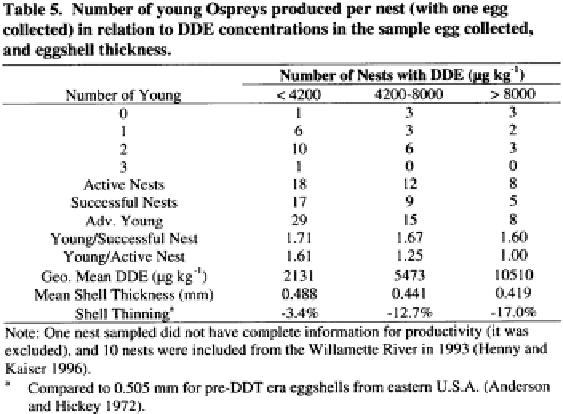Environmental Engineering Reference
In-Depth Information
Table 21
Productivity, eggshell thinning and DDE egg residues in osprey along the Columbia
River. Table 5 in Henny et al. (
2004
) reproduced with permission
southern Mexico and Central America. Another explanation could be the high
application rates of DDT to apple orchards, creating pockets of high residues in soil
and biota, including fi sh (Blus et al.
1987
).
Fish residues were stated to be elevated, although levels were not reported.
Previous investigations from 1991 to 1993 were cited by the authors to have found
an average of 0.089 ppm DDE in largescale suckers, an important food fi sh for the
ospreys. Schmitt et al. (
1990
) had reported 1.0 ppm total DDT in largescale suckers
from the Columbia River in 1984. The US EPA Region X (
2006
) reported average
total DDT residues of 0.450 ppm in largescale suckers collected in 1996-1998 from
the Columbia River Basin. Figure 2-4b from the report (Fig.
13
) illustrates the high
variability in the fi sh residues at different locations, explaining to some degree the high
variability in DDE levels in osprey eggs. A crude estimate of the biomagnifi cation
of DDE from fi sh to egg would be 4.9/(0.450-0.089) = 11-55.
Martell et al. (
2001
) used satellite telemetry to track the migration of osprey
from northern breeding areas to southern wintering areas. East coast osprey winter
primarily in Brazil, west coast osprey winter primarily in southern Mexico and
midwestern osprey winter in both locations or in between (Fig.
14
).
Mora (
1997
) reviewed available information on reports of DDT contamination of
migratory birds in Mexico. Contamination generally was found to be similar to that
in southwestern United States through the 1980s.
Rattner et al. (
2004
) reported on contaminant exposure and reproductive success of
ospreys in the Chesapeake Bay area. From a population estimated at 1,450 nesting
pairs in 1973, the Chesapeake Bay osprey population more than doubled to an
estimated 3,473 pairs by 1995-1996. However, reproduction rates have not fully
recovered in the more polluted waters of the Bay. Geometric means of DDE levels

Search WWH ::

Custom Search